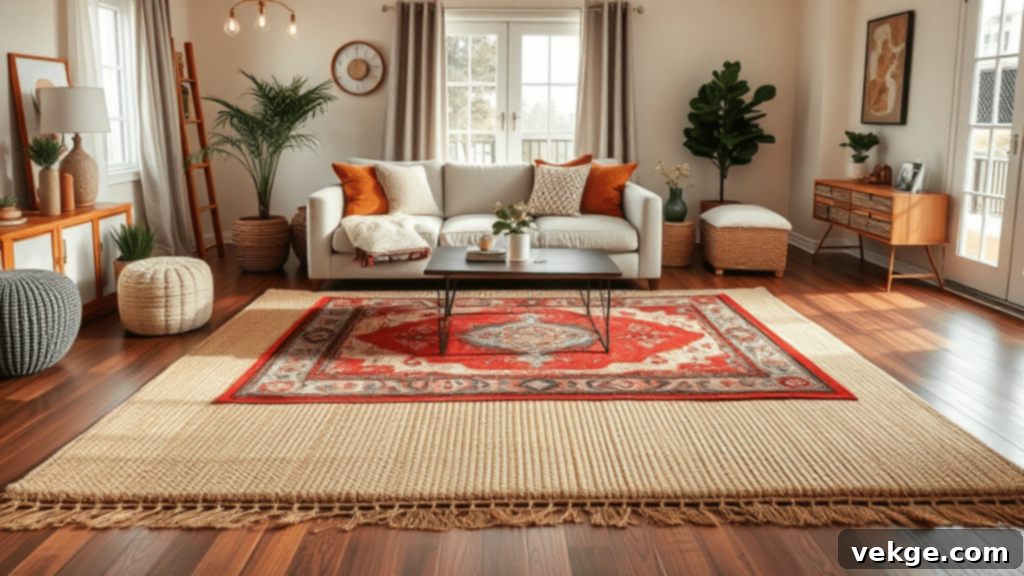Mastering the Art of Layering Area Rugs: A Comprehensive Guide to Cozy & Stylish Spaces
Transforming your living space into a haven of comfort and style doesn’t always require a complete overhaul. Sometimes, the most impactful changes come from surprisingly simple techniques. One such method, rapidly gaining popularity in interior design, is layering area rugs. Far from just stacking rugs, this creative approach adds unparalleled depth, texture, and personality to any room, making your floor feel like it’s getting a warm, inviting hug.
When you thoughtfully place one rug over another, you unlock a new dimension of design. It’s an opportunity to play with various textures, colors, and patterns, creating a truly unique and cohesive look that draws the eye and anchors your furniture. Moreover, rug layering can enhance comfort, define distinct zones within an open-plan layout, and even be a budget-friendly solution for covering larger areas.
However, before you dive into this exciting decorating trend, there are a few considerations to ensure your layered look is both beautiful and functional. Preventing tripping hazards, securing rugs from sliding, and skillfully mixing patterns are key to achieving a polished result. Don’t worry, this guide will walk you through every step, helping you navigate the world of rug layering with confidence and creativity!
What is Rug Layering and Why is it Trending?
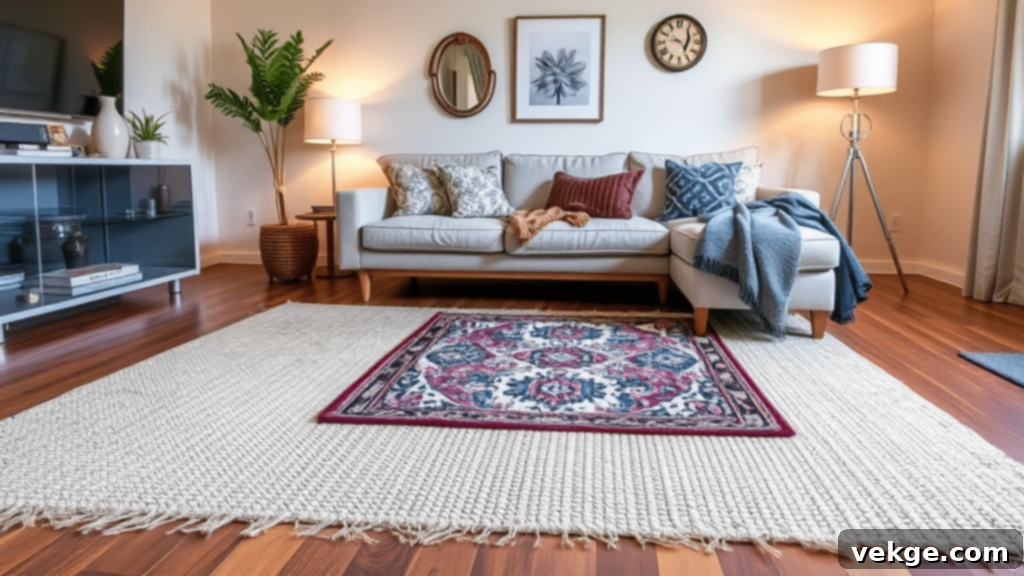
At its core, rug layering is precisely what it sounds like: placing one rug on top of another. While seemingly straightforward, this technique has evolved into a sophisticated design tool, allowing homeowners and decorators to infuse spaces with character and warmth. It’s not just about adding an extra layer; it’s about crafting a curated visual statement.
A Simple Yet Powerful Way to Add Depth and Dimension
Layering rugs is an incredibly accessible way to introduce instant visual depth to your floors. By combining different sizes, shapes, and materials, you create a dynamic interplay that makes a room feel more complete and thoughtfully designed. Imagine a large, foundational rug grounding your furniture, with a smaller, more decorative rug artfully placed on top to highlight a specific area or piece of furniture. This juxtaposition adds rich texture and an inviting complexity that a single rug simply cannot achieve.
The Latest Trend for Modern and Cozy Spaces
Rug layering has surged in popularity because it offers a versatile and relatively inexpensive way to refresh a space without investing in new furniture or undergoing major renovations. It aligns perfectly with the desire for cozy, personalized interiors that feel lived-in and comfortable. This trend allows for experimentation and personal expression, making it a favorite among those looking to update their homes with a fresh, stylish, and inviting ambiance.
Why Layer Rugs? Unlocking a World of Benefits
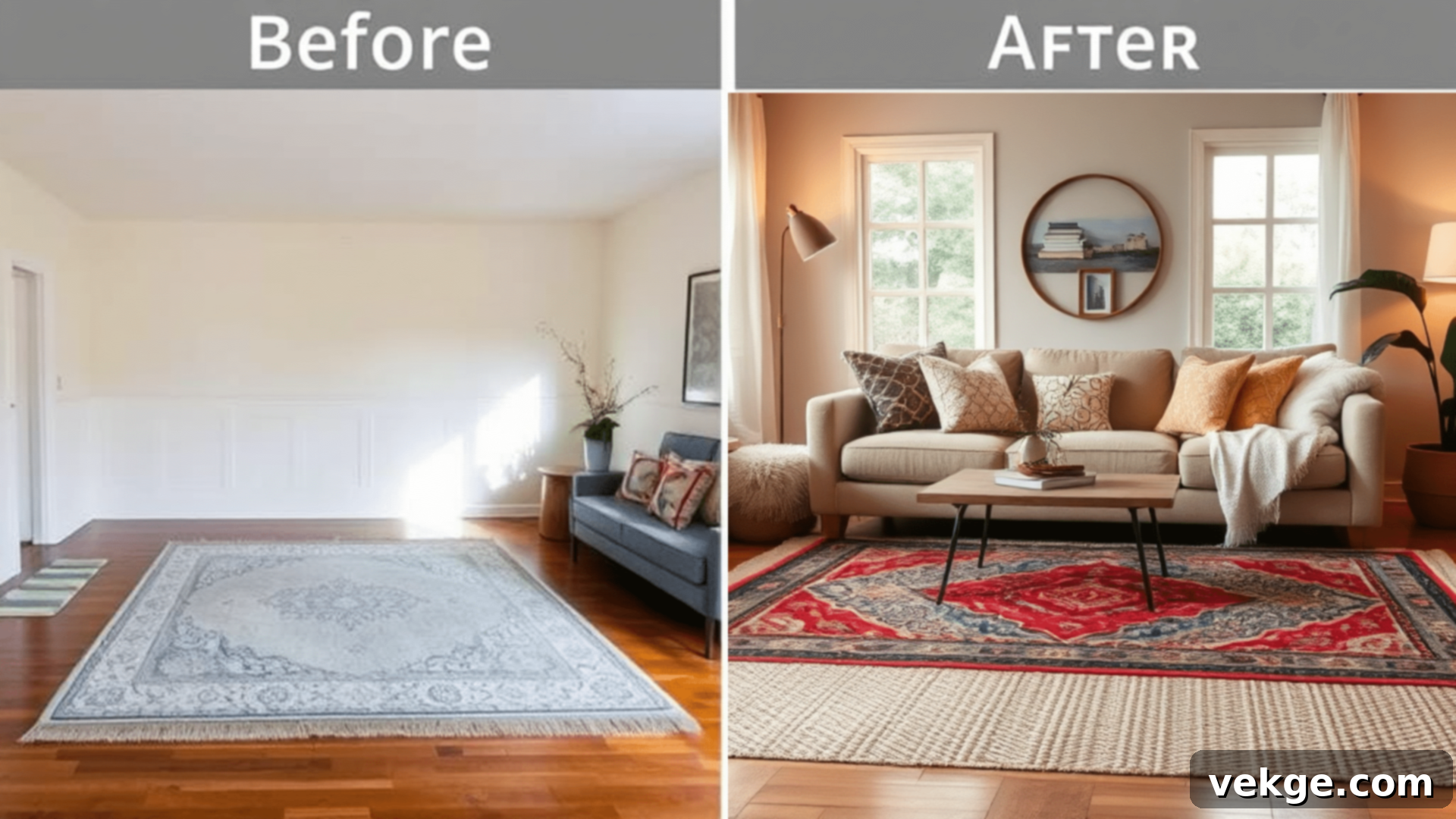
Beyond being a stylish trend, layering rugs offers a multitude of practical and aesthetic advantages that can profoundly impact the look and feel of your home. Here’s a deeper dive into why this technique is a game-changer:
1. Elevate Your Room’s Aesthetic Appeal
Layering rugs is akin to giving your room a sophisticated glow-up. It’s a powerful tool for introducing additional color, intricate textures, and visual depth, making the entire space feel more refined and inviting. A well-executed layered rug arrangement can transform a bland floor into a captivating focal point, drawing the eye and making your existing furniture pop. It’s an easy, yet effective, way to refresh your decor and infuse it with renewed vibrancy.
2. Enhance Comfort and Warmth Underfoot
There’s nothing quite like the feeling of sinking your feet into a soft, plush rug. Layering amplifies this sensation, providing extra cushioning that makes your floors incredibly comfortable to walk, sit, or even lie on. The added insulation also contributes to a warmer environment, which is especially welcoming on chilly mornings or during cozy evenings spent curled up on the sofa. Beyond physical comfort, the visual softness creates a more relaxed and hospitable atmosphere.
3. Define and Zone Different Areas in Open Layouts
In open-concept homes, where living, dining, and kitchen areas often flow seamlessly into one another, defining distinct zones can be a challenge. Layering rugs offers an elegant solution. By strategically placing rugs, you can create visual boundaries for different activities, such as a cozy reading nook, a dedicated conversation area, or a clear dining space. This technique helps to organize large, undifferentiated spaces, making them feel more purposeful and intimate without the need for physical barriers.
4. Cover More Ground Economically
Large area rugs, especially those of high quality, can be a significant investment. Layering smaller, more affordable rugs provides a smart and budget-friendly alternative to cover expansive floor areas. You can use a larger, inexpensive base rug (like jute or sisal) and then add a smaller, more decorative rug on top to introduce color and pattern. This allows you to achieve that luxurious, pulled-together look without breaking the bank, making high-end style accessible.
5. Express Personal Style and Creativity
Perhaps one of the most exciting aspects of rug layering is the freedom it offers for personal expression. It allows you to mix and match different styles, eras, and cultural influences to create a space that genuinely reflects your personality. Whether you prefer a bohemian vibe, a modern minimalist aesthetic, or a classic traditional look, layering rugs empowers you to curate a space that feels uniquely yours, showcasing your individual taste and flair.
Best Rug Combinations for Striking Layered Looks
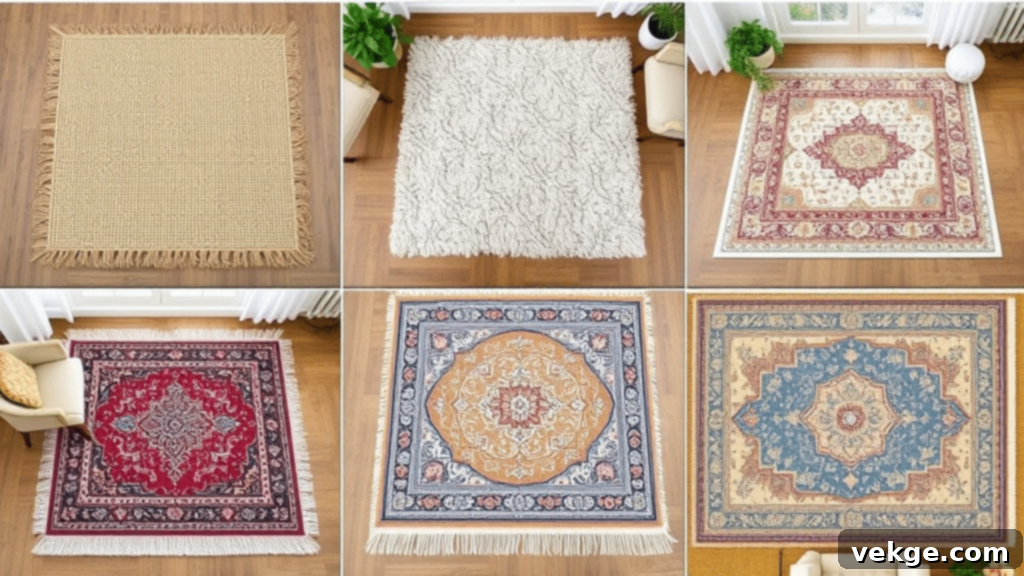
Now that you understand the compelling reasons to embrace rug layering, let’s explore some tried-and-true combinations that consistently deliver stunning results. These pairings offer a perfect starting point for your own creative endeavors:
1. Natural Jute or Sisal + Colorful Patterns
A natural fiber rug, such as jute or sisal, acts as the ultimate versatile foundation. Its organic texture and neutral color palette provide a grounding base that complements virtually any design aesthetic. When paired with a vibrant, patterned rug on top, the combination creates a harmonious balance. The natural rug’s simplicity allows the intricate patterns and bold colors of the top layer to truly shine, resulting in a look that is both sophisticated and inviting. This pairing is a foolproof way to introduce color and character without overwhelming the space.
2. Flat Weave + Plush Shag or High-Pile
Combining rugs with contrasting pile heights is a fantastic way to introduce dynamic visual interest and a delightful tactile experience. A low-pile or flat-weave rug (like a kilim or flat-woven wool) provides a stable, clean base, while a luxurious high-pile or shag rug layered on top adds incredible softness and depth. This duo creates a cozy oasis, perfect for living rooms or bedrooms where comfort is paramount. The difference in texture makes the arrangement feel rich and luxurious underfoot.
3. Neutral Solid + Bold Statement Piece
If you’ve fallen in love with a striking, intricately patterned, or brightly colored rug, but worry it might dominate the room, a neutral solid-colored base rug is your best friend. A large rug in a muted tone (think cream, grey, taupe, or soft beige) provides a calming canvas that allows your statement piece to pop without feeling overwhelming. This combination ensures that your eye-catching rug becomes the star of the show, balanced by the understated elegance of the foundational layer.
4. Vintage Charm + Modern Edge
For those who appreciate character and storytelling in their decor, mixing a vintage or antique rug with a modern design offers a captivating contrast. The historical richness and unique patina of an older rug bring a sense of history and warmth, while a contemporary rug introduces fresh patterns, colors, or minimalist lines. This blend creates an eclectic, curated look that feels both timeless and current – a true conversation starter that bridges eras.
5. Geometric Contrast: Circles + Rectangles
Beyond texture and pattern, playing with different shapes can add another layer of intrigue. Layering a round rug over a rectangular or square base rug is an excellent technique to soften the angular lines of a room and create a more intimate seating area within a larger space. The curved edges of the round rug offer a beautiful contrast to the straight lines of the foundational rug, making the space feel more organic, balanced, and inviting for conversation.
6. Solid Color + Subtle Texture
Sometimes, simplicity is key. For a minimalist yet rich look, pair a solid-colored base rug with a subtly textured rug in a similar or complementary color. Think a soft wool flatweave under a textured chenille or a Moroccan-inspired berber. This creates a monochromatic or tone-on-tone effect that speaks of understated elegance and sophisticated layering without relying on bold patterns.
Steps to Layering Rugs Like a Professional Designer
Achieving a beautiful and functional layered rug look is easier than you might think. Follow these five key steps to ensure your arrangement is cohesive, safe, and stylish:
- Step 1: Choose Your Neutral Base Rug Wisely. This is your anchor. Opt for a larger rug (typically 8×10 or 9×12 for a living room) that is either a solid neutral color or has a subtle, natural texture (like jute, sisal, or a low-pile wool). This rug should be large enough to define the entire seating area, with at least the front legs of your main furniture pieces resting on it. Its primary role is to ground the space and provide a quiet backdrop for your top layer.
- Step 2: Select a Smaller Rug with a Complementing or Contrasting Design. Now for the fun part! This top rug is where you introduce personality. It should be smaller than your base rug, allowing at least 12-18 inches of the base rug to show around its edges. Choose a design that either harmonizes with your room’s existing color palette and style or provides a deliberate, exciting contrast in pattern, color, or texture.
- Step 3: Overlap Rugs with a Strategic Size Difference. The visual appeal of layered rugs heavily relies on the size difference. Aim for a top rug that is approximately two-thirds to three-quarters the size of your base rug. This proportion ensures that the layering effect is clear and intentional, avoiding the look of two mismatched rugs accidentally overlapping.
- Step 4: Adjust Positioning for Optimal Visual Impact. Experiment with how you position the top rug on the base.
- Centered: For a classic, balanced look, place the smaller rug perfectly centered on the larger one.
- Offset: For a more modern, asymmetrical vibe, try shifting the smaller rug slightly off-center.
- Angled: A more playful approach involves placing the top rug at a diagonal, which can add dynamic energy to a space. Consider your room’s layout and furniture placement when deciding.
- Step 5: Secure the Layers for Safety and Stability. This step is non-negotiable for both aesthetics and safety.
- Rug Pads: Place a non-slip rug pad underneath your base rug to prevent it from sliding on hard floors.
- Rug Tape: For the top rug, use double-sided carpet tape to secure it to the base rug, especially around the edges. This prevents curling, bunching, and potential tripping hazards.
- Furniture Placement: Where possible, anchor both rugs with furniture (like the legs of a sofa or armchair) to add extra stability.
Room-by-Room Rug Layering Tips for Every Corner of Your Home
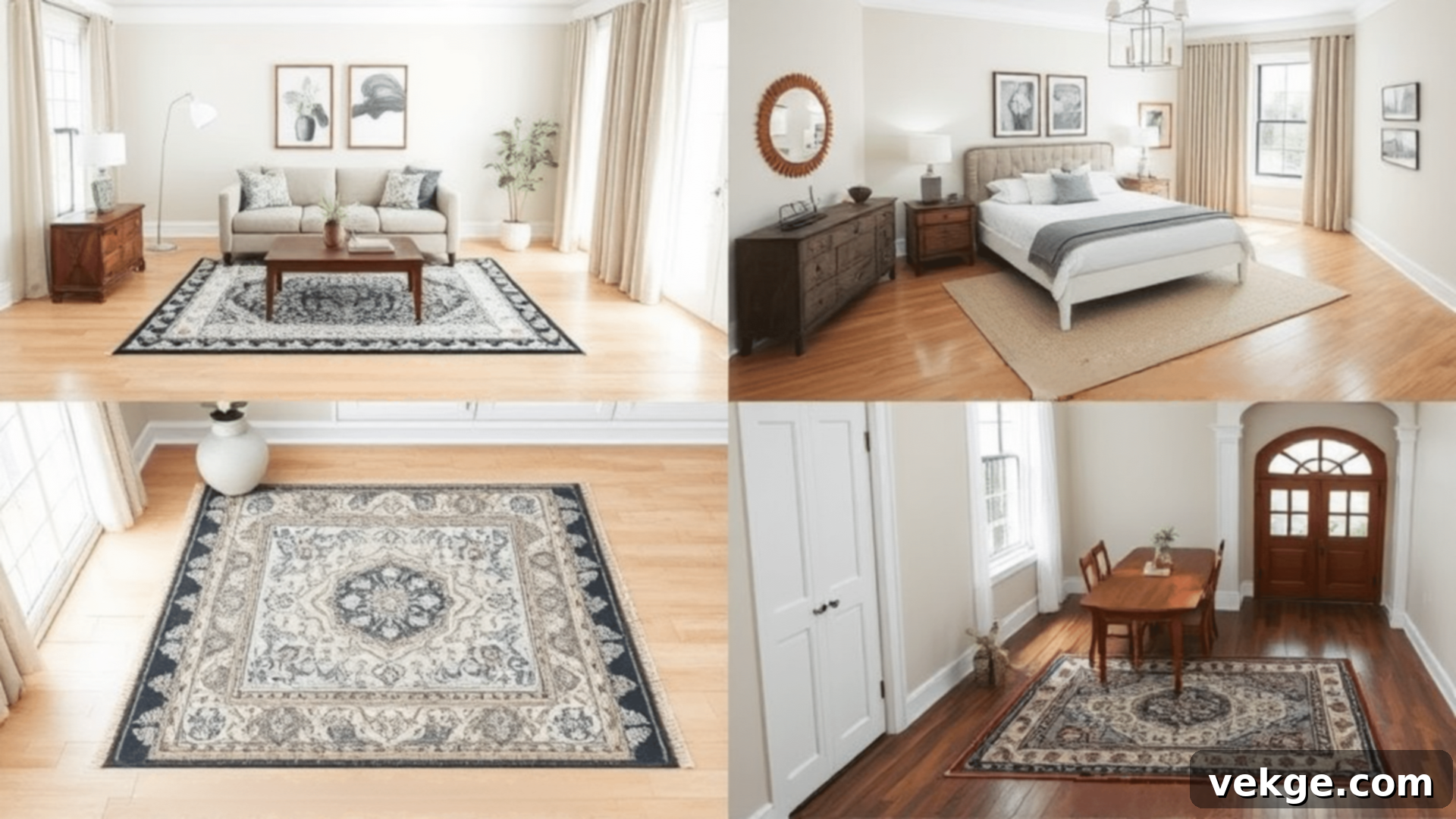
The beauty of rug layering is its adaptability to almost any room. Here’s how to apply these principles effectively in different areas of your home:
Living Room: The Heart of Layering
The living room is arguably the prime candidate for rug layering due to its size and central role in entertaining and relaxation. A large foundational rug (e.g., a 9×12 or 8×10) serves to anchor the entire seating arrangement, with all main furniture pieces having at least their front legs on it. On top, a smaller rug (e.g., a 6×9 or 5×8) can be placed to define the central conversation area or highlight a coffee table. For smaller living rooms, a 5×8 base with a 3×5 top rug works wonderfully. For expansive spaces, consider an 11×14 base with an 8×10 top layer. Experiment with plush textures for the top layer to maximize comfort and warmth.
Bedroom: Creating a Cozy Sanctuary
Your bedroom should be a serene and inviting retreat, and layered rugs can significantly contribute to that atmosphere. Start with a large, soft rug that extends beyond the sides and foot of your bed. Then, add smaller, plush rugs or runners. For a twin or full bed, a small, soft rug at the foot can add a charming accent. Queen and king beds benefit beautifully from a runner placed on either side of the bed, or a smaller, round rug partially tucked under the foot. Focus on soft, comforting textures like wool or faux fur for the top layers to enhance the cozy feel. Always ensure the rugs are not placed so close to the bed that they become a tripping hazard, especially in the dark.
Dining Room: Practicality Meets Style
Layering rugs in the dining room is entirely feasible, provided you prioritize practicality and proper sizing. The key here is to ensure the top rug is large enough that all dining chairs remain on the rug, even when pulled out from the table. This prevents chairs from catching on rug edges and makes movement smooth. Opt for durable, easy-to-clean materials like wool or synthetic blends (nylon, polypropylene) for both layers, as dining rooms are prone to spills. Regular vacuuming and immediate spot-cleaning are essential to maintain a fresh, inviting look.
Entryway: Making a Grand First Impression
The entryway sets the tone for your entire home, and layered rugs can make a welcoming and stylish first impression. Given the high foot traffic, prioritize durability and low-pile options for the base rug, such as jute, sisal, or a sturdy flat-weave. On top, you can introduce a smaller, more decorative rug with a pop of color or an interesting pattern. This combination handles wear and tear efficiently while still adding visual appeal. Choose colors and patterns that reflect your home’s overall aesthetic and evoke a sense of warmth and invitation.
Home Office or Nursery: Adding Personality and Softness
In a home office, layering can add a touch of personality and reduce echo, creating a more focused environment. A larger rug can define the workspace, with a smaller, softer rug under a reading chair or at the desk for comfort. For nurseries, layering soft, washable rugs can add warmth, cushioning for playtime, and a charming aesthetic. Prioritize non-toxic, easy-to-clean materials for baby-friendly spaces.
Common Mistakes in Rug Layering & How to Avoid Them
While rug layering is a fantastic way to elevate your decor, there are a few common pitfalls that can detract from its effectiveness. Being aware of these missteps can help you create a polished and professional look:
1. Too Matchy-Matchy Textures or Patterns
The essence of layering lies in creating visual interest through contrast. Using rugs with identical textures (e.g., two plush shag rugs) or overly similar patterns can make the arrangement look flat, monotonous, and defeat the purpose of layering. Instead, mix it up! Pair a smooth, flat-weave rug with a chunky knit, a sisal with a wool, or a subtle pattern with a bold one. The contrast adds depth and character.
2. Clashing Colors and Patterns
While contrast is good, clashing is not. Not all colors and patterns are meant to coexist harmoniously. Avoid pairing patterns that compete too aggressively or colors that visually fight each other. A good rule of thumb is to stick to complementary hues or patterns that share at least one common color. If you’re hesitant, start with a neutral, solid base rug and introduce a top rug with a bolder pattern or color, ensuring the colors in the top rug either match or softly contrast elements in your room.
3. Awkward Overlaps and Incorrect Sizing
The size relationship between your base and top rug is crucial. An awkward partial overlap, where only a tiny edge of the base rug shows, or a top rug that’s too large for the base, can look like a mistake rather than an intentional design choice. Ensure there’s a clear, consistent border of the base rug visible (typically 12-18 inches). The top rug should always be significantly smaller than the bottom to create a purposeful layering effect, never almost the same size.
4. Slip and Slide – Neglecting Safety
A layered rug arrangement that shifts and slides is not only frustrating but also a significant tripping hazard. This is perhaps the most critical mistake to avoid. Always use a high-quality non-slip rug pad underneath your large base rug, especially on hard floors. For the top rug, secure it to the base rug using double-sided carpet tape, particularly around the perimeter. This ensures both layers stay firmly in place, providing stability and peace of mind.
5. Too Thick or Bulky Layers
While plush rugs are wonderful for comfort, layering two very thick, high-pile rugs can create an overly bulky look and, more importantly, a substantial tripping hazard. It can also make vacuuming and cleaning more difficult. For the top layer, especially in high-traffic areas, opt for a rug with a lower pile height (ideally less than 1/2 inch) or a flat weave. If you want a plush feel, use a thick rug pad under your base rug, or choose a flat base and a moderately plush top layer.
Budget-Friendly Rug Layering Ideas to Style on a Shoestring

You don’t need a lavish budget to achieve a stunning layered rug look. With a little creativity and savvy shopping, you can create a high-end feel without the hefty price tag:
Affordable Rug Combinations That Deliver Impact
The key to budget-friendly layering often lies in using an inexpensive base rug. Pair a large, simple jute, sisal, or synthetic flat-weave rug (which are often very affordable) with a smaller, patterned flat-weave rug from a discount retailer. You can also layer two inexpensive solid-color rugs in complementary hues for a sophisticated, monochromatic look. Look for sales on basic wool rugs or consider outdoor rugs for indoor use as they are often more durable and cost-effective.
Smart Shopping: Where to Find Bargains
Hunting for deals is essential! Consistently check discount home stores like TJ Maxx, HomeGoods, and Overstock for surprisingly good finds. Online retailers such as Wayfair, Rugs USA, and even Amazon frequently have sales, clearance sections, and budget-friendly options that rotate regularly. Don’t overlook local thrift stores, flea markets, or Facebook Marketplace for unique vintage finds that can serve as a charming top layer.
DIY Hacks for Unique Layered Looks
Unleash your inner crafter! Old blankets, beautiful quilts, or even large fabric scraps with interesting patterns can be repurposed as a top layer over a basic, inexpensive rug. Secure the edges with fabric glue or simple stitching. For a truly custom look, consider painting a plain, flat-weave rug with fabric paint. Geometric patterns or simple stripes can transform a drab rug into a bespoke statement piece, adding a personal touch that no store-bought rug can replicate.
How to Maintain Your Layered Rugs for Lasting Beauty
Keeping your layered rugs looking their best is crucial for longevity and aesthetic appeal. Fortunately, it doesn’t have to be a complicated chore:
Cleaning Made Easy: Regular Care and Spot Treatment
Regular vacuuming is your first line of defense against dirt and dust. Make sure to vacuum your top rug frequently, and periodically lift it to vacuum the base rug as well. For deeper cleaning, always check the care labels on each individual rug and follow the manufacturer’s instructions. Address spills immediately by spot-cleaning with a clean cloth and appropriate rug cleaner to prevent stains from setting. Quick action is key, especially with layered rugs, as spills can seep through.
Keep Them in Place: The Power of Rug Pads
As mentioned before, a high-quality non-slip rug pad underneath your base rug is essential. Not only does it prevent dangerous slipping and sliding, but it also adds extra cushioning, protects your floors, and can extend the life of your rug by reducing wear and tear. Invest in a pad that is slightly smaller than your base rug (about one inch shorter on all sides) to avoid it showing.
The Double-Sided Tape Trick for Stubborn Layers
For any top rug that tends to shift or curl at the edges, even with furniture anchoring it, double-sided carpet tape is your secret weapon. Simply apply strips of the tape to the underside of the top rug, especially around its perimeter and corners, then firmly press it onto the base rug. This simple trick will keep your layered arrangement perfectly aligned and secure, preventing annoying bunching and potential hazards.
Rotate and Refresh
To ensure even wear and exposure to sunlight, consider rotating your rugs periodically. This helps prevent certain areas from fading or wearing out faster than others. If you have reversible rugs, flipping them can also extend their lifespan. For a complete refresh, consider professional rug cleaning every few years, especially for natural fiber rugs or those in high-traffic areas.
Conclusion: Embrace the Art of Rug Layering for a Beautiful Home
And there you have it – a comprehensive guide to mastering the art of layering area rugs! As you’ve discovered, this decorating technique is far more than just a trend; it’s a powerful and versatile tool for injecting warmth, texture, and personality into your home. It’s a chance to truly make your space feel cozy, inviting, and uniquely yours.
Remember, the beauty of rug layering lies in its flexibility. Don’t be afraid to experiment with different textures, colors, and patterns. Start with a solid foundation, play with your top layer, and adjust until you find a combination that truly resonates with your personal style and makes your heart sing. Whether you’re aiming to define zones in an open-plan living room, add luxurious comfort to your bedroom, or simply refresh a tired space on a budget, layered rugs offer an accessible and impactful solution.
With these tips and tricks in your back pocket, you’re well-equipped to tackle any rug layering project with confidence. So go ahead, get creative, and enjoy the transformative power of layered rugs. Happy decorating, and may your floors be forever fabulous and incredibly inviting!
